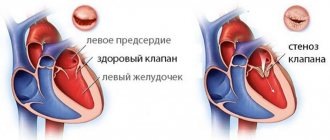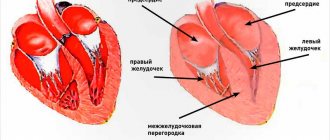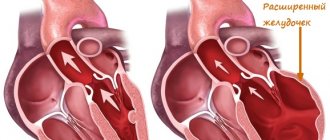Heart failure - what is it?
Heart failure in dogs is a condition in which the heart loses its ability to pump enough blood and can no longer meet the body's oxygen needs. The result is a decrease in the intensity of blood circulation, a slowdown in metabolic processes and disruption of the functioning of internal organs.
Some dog breeds are predisposed to this disease, so their owners need to be especially careful. Among them:
- collie,
- shepherd,
- English bulldog,
- schnauzer,
- boxer,
- spaniel,
- fox terrier.
Heart failure in dogs: symptoms and treatment
Diagnosis and treatment of heart failure in dogs should be carried out urgently if the following signs are noticed.
- fatigue, lethargy, weakness;
- dyspnea;
- cyanosis of mucous membranes;
- gurgling wheezing and sounds when breathing;
- cough that sounds like gagging;
- overweight and underweight;
- increase in abdominal volume;
- the dog has poor coordination of movement;
- rapid breathing and pulse;
- when the animal sits, its paws are widely spaced and its chest is straightened forward;
- chills and occasional fainting;
- high blood pressure.
If you have at least one of these signs, you should immediately contact a veterinarian. He prescribes appropriate treatment, as well as a special diet and possible physical activity.
Causes of heart failure
Stress, long-term use of certain medications, obesity combined with physical inactivity, as well as kidney disease are factors that provoke the development of heart failure in dogs. Symptoms of this condition are usually seen in dogs over 7 years of age. With improper care, the clinical picture appears much earlier.
In dogs of toy breeds (for example, toy terriers), the most common cause of heart failure is emotional overload.
Other reasons that provoke the development of heart muscle failure:
- Congenital anomalies of the myocardium.
Gastric septal defect, patent ductus arteriosus and other defects of the heart valve apparatus can lead to impaired circulation of the heart muscle. As a rule, they appear within 4-6 months after the birth of the pet.
- Inflammatory processes affecting the myocardium.
Damage to the serous membrane of the heart (pericarditis), the heart muscle (myocarditis) or the inner lining of the heart (endocarditis) are the most common inflammatory diseases found in dogs of different ages.
- Damage to blood vessels.
Various diseases of the vascular system (for example, hypertension and atherosclerosis) significantly increase the load placed on the heart muscle. As a result, cardiac diseases develop, one of which may be heart failure.
- Cardiomyopathy.
Structural and functional changes in the heart muscle can trigger infections (eg, viral, fungal, bacterial) suffered by the dog. If they provoke the proliferation of connective tissue, then myocardial hypoxia gradually develops.
- Intense physical activity.
Improperly planned or excessive physical activity (for example, long runs over long distances, strength exercises, etc.) often lead to premature wear of the heart muscle in large breed dogs.
- Endocrine system disorders.
Diseases provoked by hormonal imbalances in the body, pathologies of the thyroid gland and diabetes mellitus lead to the development of congestion in the heart muscle, which is chronic.
Causes of heart failure in dogs
They may vary depending on age and the general clinical picture of the disease. Basically, they are represented by the following negative factors:
- Infection. Some purulent processes can negatively affect the heart muscle, poisoning it with toxins. This can be caused by an abscess in a tooth or a prolonged sore throat.
- Inflammatory process in the heart muscle. This can occur against the background of injury associated with a general weakening of the body caused by hypothermia, general dysfunction of the circulatory system or lack of vitamins.
- Violation of the mechanical and electrical functionality of the heart muscle, caused by congenital defects and poor patency of nerve endings for signals sent by the brain. This can be acquired with age.
- Incorrect hormonal levels regulated by the thyroid gland and adrenal cortex.
- Impaired blood circulation in the so-called crown of the heart. This is the upper part of the vessels entering this organ. This is triggered by injury or congenital characteristics. It can also be caused by poor nutrition over a long period of time.
- Formation of sclerotic plaques and hypertension in the ventricles of the heart. The size of the organ increases and it cannot pump blood as well as before.
- A number of parasitic worms take up residence in the muscles, reducing their primary function. Even after they are eliminated, the circulatory system will not work normally. But this is usually the result of their long-term activity; you need to regularly give your pet the appropriate medications.
- Self-medication with hormonal drugs can lead to serious problems.
Clinical picture: main symptoms of the disease
With heart failure, the dog experiences chills, drowsiness and constant weakness. If a pet develops cerebral hypoxia as a result of the disease, fainting often occurs. All mucous membranes (for example, gums and tongue) acquire signs of cyanosis, that is, they change their color to violet-bluish.
What happens in dogs with heart failure?
- Decreased activity.
The dog gets tired quickly, avoids physical activity (for example, training and walking), and increasingly refuses active games. The pet begins to move with caution: walks slowly, does not jump on stairs, etc.
- Heavy breathing, shortness of breath.
The first thing many owners pay attention to is breathing problems. If in the initial stages they occur only after intense physical exertion, then over time shortness of breath appears even in a calm state.
- Decreased appetite.
The animal quickly loses muscle mass, rapidly loses weight, and anorexia develops. In the initial stages of the disease, severe thirst is observed. Subsequently, problems with appetite arise. Animals even refuse their favorite food.
- Cough.
If your dog has heart failure, he or she may cough. At first - rare attacks. As the disease progresses, the cough becomes more frequent and debilitating. This is caused by enlargement of the hypertrophied heart muscle and compression of the trachea.
- Strange poses.
The pet changes its gait, as well as its posture when lying down or sitting. Typically, in case of heart failure, the animal sits down with its front legs spread wide. In this case, the chest area protrudes greatly and becomes tense.
- Ascites.
The abdominal area increases as a result of the accumulation of fluid in the peritoneum. This is an important signal indicating a severe circulatory disorder. The manifestation of this symptom indicates the last stages of the development of heart failure.
Types of disease: characteristic features
Left-sided heart failure (LSF ). It affects the left half of the heart more, so it most often manifests itself in the form of pulmonary edema. In this case, the pressure in the left atrium increases, and the pumping function of the myocardium decreases. All this is caused by the fact that the left ventricle does not push the required volume of blood into the systemic circulation.
Characteristic features:
- rapid breathing,
- accumulation of fluid in the lung tissue,
- dry cough,
- short-term disturbance of consciousness,
- fast fatiguability.
Right-sided heart failure (RSF) . Impaired pumping function of the right ventricle, which does not push the required volume of blood through the lungs. More often, right-sided heart failure leads to edema of peripheral tissues and the intermaxillary space, with fluid leaking into the chest, pericardial and abdominal cavities.
Characteristic features:
- sagging abdominal area,
- breathing complication
- X-shaped paw placement,
- neck stretching,
- swelling of the limbs.
Acute and chronic heart failure: differences
Acute heart failure (AHF) . Its main difference is its high speed of development. In dogs, it develops against the background of large blood loss, severe infectious diseases, etc. In addition, it can occur at some stages of chronic heart failure (CHF). In case of AHF, emergency first aid by professionals is required. Only in a veterinary clinic will it be possible to relieve the pet’s acute condition.
Chronic heart failure (CHF) . Among the most common reasons: hormonal imbalances and excessive physical activity that does not correspond in intensity to the animal’s body weight. The main difference is the slow and constant increase in clinical signs over several months or even years. All symptoms manifest themselves in stages: from breathing problems to ascites. In addition, chronic heart failure is characterized by severe exhaustion of the pet.
Chronic heart failure in dogs
Heart failure is a common cause of deterioration in the quality of life of an animal and its owner.
Heart failure is the inability of the heart to circulate enough blood to meet the body's metabolic needs.
Failure is distinguished between chronic and acute. These forms of the disease differ in the speed of development and increase in symptoms, as well as the underlying disease.
Chronic heart failure (CHF) develops over a long period of time. CHF can be considered as a consequence of any underlying disease of the cardiovascular system.
Acute heart failure (AHF) has a lightning-fast course and often does not have any prerequisites for the development of the disease.
Modern veterinary medicine, like human medicine, does not consider chronic heart failure in animals as an independent disease; this condition occurs as a consequence or complication of certain diseases. In this case, the heart cannot function properly - to ensure normal blood flow to all organs and tissues. In this regard, over time, when the circulation of nutrients and oxygen is disrupted, stagnation occurs in the animal’s body, which leads to the appearance of clinical signs.
Symptoms of chronic heart failure in dogs
Like all diseases, chronic heart failure has its symptoms. But there is a characteristic feature - the disease develops quite slowly and the body manages to adapt to changes in the functioning of the heart. In the early stages of the disease, deterioration in the pet’s condition is difficult to notice, but it becomes most pronounced during physical activity or in hot weather.
The main symptoms for which the owner needs to contact a specialist are:
- Shortness of breath (which may also occur at rest)
- Cough (owners often feel that the dog is choking on something and cannot clear its throat. Over time, the cough begins to bother the animal at night)
- Increased fatigue. The dog begins to get tired faster than usual and after exercise it takes longer to return to normal.
- Blue discoloration (cyanosis) of visible mucous membranes and tongue. Most often occurs after exercise
- Loss of consciousness or fainting - occurs suddenly and, as a rule, without prerequisites
- Increase in abdominal volume, often against the background of general weight loss. That is, the animal loses subcutaneous fat, and the ribs and spinous processes of the vertebrae begin to be felt, while the abdomen enlarges and takes on a spherical shape and becomes tense to the touch. This condition is called ascites, or the accumulation of fluid in the abdominal cavity.
Causes of chronic heart failure in dogs
Heart failure itself is extremely rare. In young animals, CHF is most often caused by congenital heart defects. Elderly animals can suffer from chronic heart failure against the background of almost any disease of the cardiovascular system. For example:
- cardiomyopathies (diseases characterized by changes in the geometry of the heart muscle itself, which as a result leads to impaired blood circulation in the systemic or pulmonary circulation)
- arterial hypertension (high blood pressure)
- heart defects (both congenital and acquired)
- heart valve diseases
Also, chronic heart failure in dogs can occur as a complication after illnesses of the kidneys, lungs, liver, or endocrine system.
In addition, there are risk groups - dogs in this group are more prone to heart disease. The risk group includes animals over 6 years old, large and prone to obesity, as well as representatives of certain breeds (giant breeds, also Doberman Pins and Boxers, dogs of dwarf breeds and breeds with an excitable nervous system).
Diagnosis of CHF in the clinic
In the clinic, heart failure will be determined fairly quickly. For the initial diagnosis, it is very important to correctly describe the nature of the changes in the pet’s condition. The owner will definitely need information about feeding and exercise regimen, vaccinations and past diseases and surgical interventions. The more detailed you describe to the doctor what worries you, the faster the doctor will be able to get his bearings and prescribe the necessary additional instrumental studies.
Further, heart failure is diagnosed as follows. After obtaining a complete picture of the animal’s condition from the owner’s words and a clinical examination by a specialist, hardware diagnostic measures follow.
- X-ray examination is a reliable, proven way to assess the size of the heart and the condition of the lungs. On an x-ray, we can also see signs of fluid accumulation in the chest or abdominal cavities, which will undoubtedly help the doctor in making the correct diagnosis.
- Electrocardiogram - determines any disturbances in the rhythm of the heart, identifies the type of arrhythmia.
- Echocardiography is a diagnostic method that clearly identifies structural heart diseases. An echo allows you to see the condition of the heart valves, the size of the chambers of the heart muscle and identify congenital defects.
- Laboratory diagnosis involves blood tests to identify concomitant systemic diseases.
Treatment of chronic heart failure in dogs
The method of treating the animal depends on the underlying disease as a result of which heart failure developed. Usually it is impossible to completely eliminate the cause of the disease, so drug therapy is prescribed for life with the condition of periodic monitoring of the animal’s condition by a doctor. This period of time is individual for each patient.
Medications are prescribed to your dog to eliminate or minimize symptoms. With the help of medications you can reduce shortness of breath, swelling, tachycardia, and increase overall vitality. Drug therapy can slow the progression of the underlying disease, thereby prolonging and improving your animal's life.
Non-drug treatment of heart failure in dogs is also important. Often the disease develops as a result of obesity - accordingly, a strict diet is necessary to normalize weight, usually salt-free. This diet is developed by a nutritionist based on the indications of the cardiologist and the general condition of the animal. After returning to normal weight and for the rest of your life, you will also need to adhere to a dietary diet - a program should also be developed by a specialist, possibly feeding with ready-made dietary foods.
In case of heart failure, strictly dosed exercises play an important role in normalizing the dog’s condition - recommendations are given by the doctor. All exercises must be strictly regulated. The owner needs to control all stress and such attention should be provided to the animal throughout its life.
Diagnosis of the disease in dogs
The first thing experienced veterinarians begin with is an initial examination. During a visual examination and obtaining data from the dog owner, the specialist diagnoses shortness of breath, cyanosis of the mucous membranes, peripheral edema, as well as other signs characteristic of acute or chronic heart failure.
Diagnostic methods used:
- X-ray examination . It allows you to identify congestion in the pulmonary circulation, as well as the presence of fluid in the chest cavity;
- Electrocardiography (ECG). It is aimed at recording and studying the electric fields arising during the functioning of the heart muscle;
- Echocardiography . It allows you to identify compensated disorders of myocardial function, therefore it is always used to diagnose heart failure.
If necessary, additional diagnostic methods are used (for example, tissue Doppler sonography). The main thing is to contact a veterinary clinic that has all the necessary equipment for a quick and accurate diagnosis of heart failure in dogs.
Diagnosis of heart failure in dogs
At the stage of initial examination
signs of obvious heart failure can be detected: shortness of breath, cyanosis of the mucous membranes, peripheral edema, and such as swelling of the jugular veins and gallop rhythm are the most significant.
During X-ray examination
detect congestion in the pulmonary circulation, cardiomegaly, elevation of the trachea, free fluid in the chest cavity.
On ECG
can be detected: changes in heart rate; foci of ectopic excitation; blockades in various parts of the conduction system; atrioventricular dissociation; supraventricular and ventricular tachycardia; atrial fibrillation and other rhythm disturbances.
Echocardiography
plays a significant role in the diagnosis of this syndrome, especially in the early stages, because
can reveal still compensated disorders of systolic and diastolic myocardial function. It is recommended to carry out ultrasound examination in B- and M-mode, using Dopplerography. A general assessment of the condition of the chest cavity is carried out: the presence of free fluid, hydropericardium. Then the cavities of the heart are examined in more detail, measurements are taken of each of the chambers and visualized vessels, identifying stretching and thinning. The flow of fluid through the valves and directly in the cavities of the chambers is characterized; blood clots are excluded in places where blood flows at a lower speed. Sometimes, assessment of total cardiac function is insufficient. In these cases, additional studies are recommended including tissue Dopplerography
,
contrasting of the cardiac cavities
,
stress-ECHO cardiography
, as well as
studies of the level of certain biomarkers
(brain or atrial natriuretic peptide, troponin I, etc.)
Treatment of heart failure
Timely contact with veterinarians is the key to effective treatment. When an animal arrives, the veterinarian first assesses the condition of its body. If urgent stabilization is required for acute heart failure, then emergency measures are taken.
Treatment tactics are based on eliminating the cause that provokes the development of the disease (for example, heartworms, congenital heart muscle defects, etc.), as well as controlling emerging clinical signs.
To carry out effective drug therapy, experts prescribe:
- Angiotensin-converting enzyme (ACE) inhibitors. They eliminate spasms, normalize blood pressure, improve the supply of oxygen to the myocardium, and also dilate the heart arteries;
- Beta blockers . They are prescribed to achieve hypotensive and antiarrhythmic effects. Drugs in this group improve myocardial perfusion. They are prescribed to pets when sinus rhythm is detected;
- Symptomatic drugs . Their intake is necessary to eliminate the clinical manifestations of heart failure. Veterinarians prescribe diuretics, cardiotropics, painkillers and other medications.
Treatment of heart failure in dogs
First of all, upon admission of the animal, the need to stabilize its condition and the procedure for conducting the study are assessed. In an acute situation, it is necessary to first remove life-threatening symptoms, and then move on to more detailed methods of assessing cardiac function.
For any type of pathology, after stabilization of the patient's condition, treatment tactics will include an attempt to eliminate the root cause (congenital heart defects, heartworms or migratory larvae of endoparasites, primary diseases) and control of associated symptoms.
The standard approach involves controlling the formation of congestion in the lung tissue and free fluid in natural cavities (ascites, hydrothorax, hydropericardium) using drugs with a diuretic effect. Taking this group is necessary on an ongoing basis, since the animal’s body is no longer able to adequately distribute the volume of fluid entering it.
In case of insufficient systolic function of the heart, a drug is needed that enhances the contractile ability of the myocardium. Prescription of this type is also necessary in cases where general contractility is within normal limits, but overload of the heart chambers with the volume of circulating blood is clearly expressed.
An increase in peripheral vascular resistance that accompanies most heart diseases should also be controlled by administering antihypertensive drugs. Two groups of drugs have proven themselves in this area and can, if necessary, be prescribed simultaneously: angiotensin converting enzyme inhibitors (ACE inhibitors) and calcium channel blockers (CCBs).
If hemodynamically significant rhythm disturbances are detected, antiarrhythmic drugs are prescribed. In emergency cases, intravenous administration of the drug or continuous infusion is necessary until the patient's condition is stabilized.
An additional aspect of the treatment of heart failure is the control of the neurohormonal pathogenesis. First of all, there is a question about the use of aldosterone antagonists, due to its contribution to disturbances in the pressure control apparatus and stimulation of fibrosis of myocardial tissues. If necessary, but with great caution, beta-blockers are used.
If it is possible to transfer the animal to outpatient treatment, the animal should receive the necessary groups of drugs in tablet form. The quality and life expectancy of the animal will depend on the attention and responsibility of the owner.
In some cases, standard therapy is not enough, due to the long course of the disease and severe changes in the morphology of the myocardium, kidneys, and lung tissue. Therefore, it is necessary to add drugs that also act on other systems. These include: antitussives, bronchodilators, sedatives, nutrients.
Proper care at home
The task of experienced veterinarians is to prevent irreversible consequences in the dog’s health, normalize its condition and eliminate the clinical manifestations of heart failure. However, in addition to drug treatment, your pet requires proper care at home.
If your pet is diagnosed with acute or chronic heart failure, you will need to follow a set of measures:
- dose physical activity,
- provide emotional peace
- eliminate stressful situations,
- change your pet's diet by adding foods high in thiamine, magnesium, selenium and vitamin E.
Remember: the sooner you seek professional veterinary help, the greater the chance of your pet returning to a healthy life!










